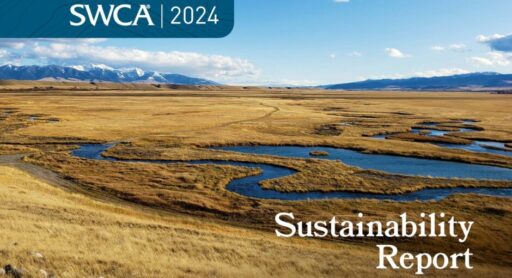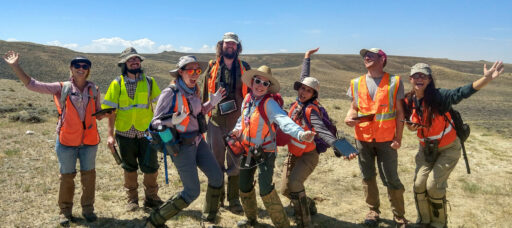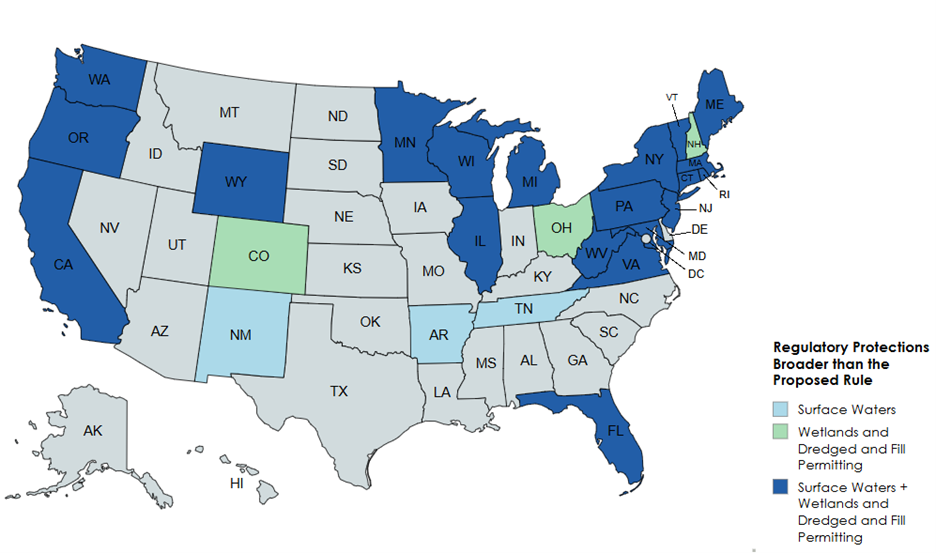2025
Comparably’s Best Company Outlook
* Providing engineering services in these locations through SWCA Environmental Consulting & Engineering, Inc., an affiliate of SWCA.

From the experts we hire, to the clients we partner with, our greatest opportunity for success lies in our ability to bring the best team together for every project.
That’s why:

At SWCA, sustainability means balancing humanity’s social, economic, and environmental needs to provide a healthy planet for future generations.

SWCA employs smart, talented, problem-solvers dedicated to our purpose of preserving natural and cultural resources for tomorrow while enabling projects that benefit people today.

At SWCA, you’re not just an employee. You’re an owner. Everyone you work with has a stake in your success, so your hard work pays off – for the clients, for the company, and for your retirement goals.
Ten Things to Know About the Proposed 2025 WOTUS Rule
Erica Gaddis, Ph.D. serves as SWCA’s Vice President of Scientific & Technical Services, where she leads the company’s technical practice directors and guides enterprise-level strategies focused on scientific excellence, innovation, and career development. In her role, Erica works collaboratively with leaders across SWCA to scale technical capabilities and deliver integrated solutions for clients and communities.
With over 20 years of experience spanning environmental consulting, public service, academia, and international policy, Erica brings a wealth of expertise to her position. A proud SWCA “boomeranger,” she has dedicated a combined 10 years to the company, most recently as Senior Water Resources Technical Director. Her previous roles include Director of Utah’s Division of Water Quality, Senior Policy Advisor to the Western States Water Council, and Principal Scientist at SWCA. She regularly collaborates with the United Nations Environment Programme on integrated environmental assessments. Erica has led numerous projects and programs in water quality, hydrology, watershed management, and water resources planning.

Heath Garner is a senior ecologist and project manager. Heath has extensive experience with wildlife ecology, plant taxonomy, GPS and GIS mapping, wetland, forest, and grassland ecology, ecological restoration, forestry practice, natural resources planning, vegetation management, and public relations. These skills have contributed to project study design, technical data collection, project logistics and management capabilities related to a diversity of project and clients including residential, commercial, and industrial development, oil/gas development and midstream, conventional power generation and transmission, and renewable energy development.
Mr. Garner has more than 30 years of experience specializing in avian ecology, wetlands, environmental assessments, ecological monitoring, threatened and endangered species surveys, habitat restoration, and conservation planning. He possesses comprehensive knowledge of federal and state regulatory requirements including NEPA, ESA, CWA, MBTA, BGEPA and serves as a technical lead of the SWCA renewable energy team with expertise in rangeland grouse species, bald and golden eagles, migratory birds, and a diversity of bat species across North America.

Nathan Jones is a Principal Environmental Consultant who oversees and manages renewable energy development projects. His extensive experience includes supporting, permitting, and managing projects on federal, state, and private lands. Nathan is well-versed in regulatory frameworks such as FAST-41 (Title 41 of the Fixing America’s Surface Transportation (FAST) Act), NEPA, ESA, CWA, and NHPA, along with state and local regulations. Additionally, he offers technical assistance to other project managers in the renewable energy sector.

Luis has more than 15 years of experience working with natural resources in the public and private sectors. He leads aquatic resource projects in California and supports projects across multiple States. Luis helps clients navigate federal, state, and local waters regulations.

Simon is a Professional Wetland Scientist (PWS) and an associate project ecologist with a diverse skill set working at the interface of natural resource surveys, site feasibility studies, technical writing, permitting, and project management. He has worked on a variety of exciting projects, ranging from solar development, renewable natural gas derived from animal waste, and natural resource management for lithium mines. His experience spans the full project life cycle, including initial site feasibility studies, natural resource surveys, 404/401 permitting, Sec. 7 ESA consultation, and post-construction monitoring. He has conducted numerous wetland delineations and rare, threatened, and endangered habitat and species surveys in multiple states including Florida, Iowa, Maryland, New York, North Carolina, Ohio, Oklahoma, South Carolina, Tennessee, Virginia, and West Virginia.






On November 20, 2025, the U.S. Environmental Protection Agency (EPA) and U.S. Army Corps of Engineers (USACE) released a pre-publication of a Proposed Rule further refining the definition of waters of the United States (WOTUS) to conform with the U.S. Supreme Court’s decision in Sackett v. EPA issued on May 25, 2023. As stated in the EPA’s factsheet, the Proposed WOTUS Rule:
“…would fully implement the Court’s direction by ensuring federal jurisdiction is focused on relatively permanent, standing or continuously flowing bodies of water—such as streams, oceans, rivers, and lakes—and wetlands that are connected and indistinguishable from such waterbodies.”
The definition of WOTUS has been debated since the adoption of the Clean Water Act (CWA) in 1972. Over several decades, regulatory agencies and courts, including the U.S. Supreme Court, have made numerous efforts to interpret the jurisdictional reach of WOTUS under the CWA.
More information about the rule is available on the EPA’s webpage: Updated Definition of Waters of the United States.
Below are 10 things you should know about the Proposed WOTUS Rule:
The Proposed WOTUS Rule refines definitions for important terms used in WOTUS determinations. We’ve provided them below for easy reference with a few notes from our initial analysis.
Relatively Permanent: “standing or continuously flowing bodies of surface water that are standing or continuously flowing year-round or at least during the wet season.”
Wet Season: “extended periods of predictable, continuous surface hydrology occurring in the same geographic feature year after year in response to the wet season, such as when average monthly precipitation exceeds average monthly evapotranspiration.”
Continuous Surface Connection: “having surface water at least during the wet season and abutting (i.e., touching) a jurisdictional water.”
Tributaries: “Relatively permanent tributaries include rivers, streams, lakes, ponds, and other standing or continuously flowing bodies of surface water that are standing or continuously flowing year-round or at least during the wet season, that have a bed and banks, and connect to a downstream traditional navigable water or the territorial seas, either directly or through one or more waters or natural or artificial features that convey relatively permanent flow.”
The Proposed WOTUS Rule removes interstate waters as a standalone condition for jurisdiction under the CWA. However, the agencies note that only 15 Approved Jurisdictional Determination (AJDs) in the last 10 years have been identified that were based solely on the interstate category.
The Proposed WOTUS Rule clarifies several exclusions from CWA jurisdiction as summarized in the table below.
Waste Treatment System: “all components of a waste treatment system designed to meet the requirements of the Clean Water Act, including lagoons and treatment ponds (such as settling or cooling ponds), designed to either convey or retain, concentrate, settle, reduce, or remove pollutants, either actively or passively, from wastewater prior to discharge (or eliminating any such discharge).”
Prior Converted Cropland: “any area that, prior to December 23, 1985, was drained or otherwise manipulated for the purpose, or having the effect, of making production of an agricultural product possible.”
Ditch: “A constructed or excavated channel used to convey water.”
Groundwater: Water “drained through subsurface drainage systems.”
Many states have programs to regulate “waters of the State.” The agencies estimate that at least 24 states regulate surface waters or dredge and fill activities more broadly than the Proposed WOTUS Rule. In addition, many states and localities across the United States are developing new state regulations to address aquatic resources. SWCA will be following these developments closely to ensure our regulatory experts and aquatic resource specialists comply with the changing regulations. Our teams can help evaluate state regulations to determine whether additional permitting would be needed beyond the federal requirements.

Figure 1. States with Regulatory Protections Broader than the Proposed Rule* Source: Regulatory Impact Analysis for the Proposed Updated Definition of Waters of the United States Rule
The agencies have completed a Regulatory Impact Analysis for the Proposed WOTUS Rule to evaluate the potential impacts of the proposed changes in reducing the scope of jurisdictional waters. The reduction in permit activity is projected to be greatest for the Section 404 Dredge and Fill permitting program, administered by the USACE and EPA. Agencies estimate that approximately 17.36 million acres of wetlands may retain jurisdictional status representing 19% of the 90.91 million acres of wetlands mapped in the National Wetlands Inventory. The Proposed WOTUS Rule will also reduce the scope of federal jurisdiction for other CWA programs, including Section 402 (National Pollutant Discharge Elimination System permitting), Section 303 (water quality standards, assessment, and total maximum daily loads), Section 311 (oil spills), and Section 401 (water quality certifications).
The Proposed WOTUS Rule does not fundamentally change field delineation methods for wetlands, but it will change how those delineations are used to determine jurisdiction. Some adjustments to wetland field delineations include the need to map surface water lines fully within a wetland complex and the importance of conducting delineations during the wet season to reduce uncertainty.
The agencies have outlined methods to evaluate the impact of the new rule across the country. SWCA is prepared to apply these methods to individual projects. SWCA experts and project managers can help you to understand how these proposed changes may present challenges and opportunities for your current and future projects and business. We can assist you in reviewing the implications of the new ruling on your project through the following analyses:
Project proponents may request revised delineations to limit the scope of jurisdiction for ongoing projects, even for situations with AJDs (depending on USACE review time frames). SWCA can assist with review of previous AJDs and help you to determine whether revisiting the decision would be strategically beneficial for your project.
The agencies are accepting comments on the Proposed WOTUS Rule for 45 days. Tips for preparing effective public comments are available at Regulations.gov. SWCA can also help you craft impactful and actionable comments for agency consideration in shaping any final rule changes.
We are expecting litigation shortly after the rule goes into effect and regional guidance from the agencies in 2026. In addition, many states and localities across the United States are developing new state regulations to protect aquatic resources. SWCA will be following these developments closely to ensure our regulatory experts and aquatic resource specialists comply with the changing regulations.
For more information on the Proposed WOTUS Rule, please reach out to your project manager or any of SWCA’s regulatory and aquatic resource experts to the left to discuss.